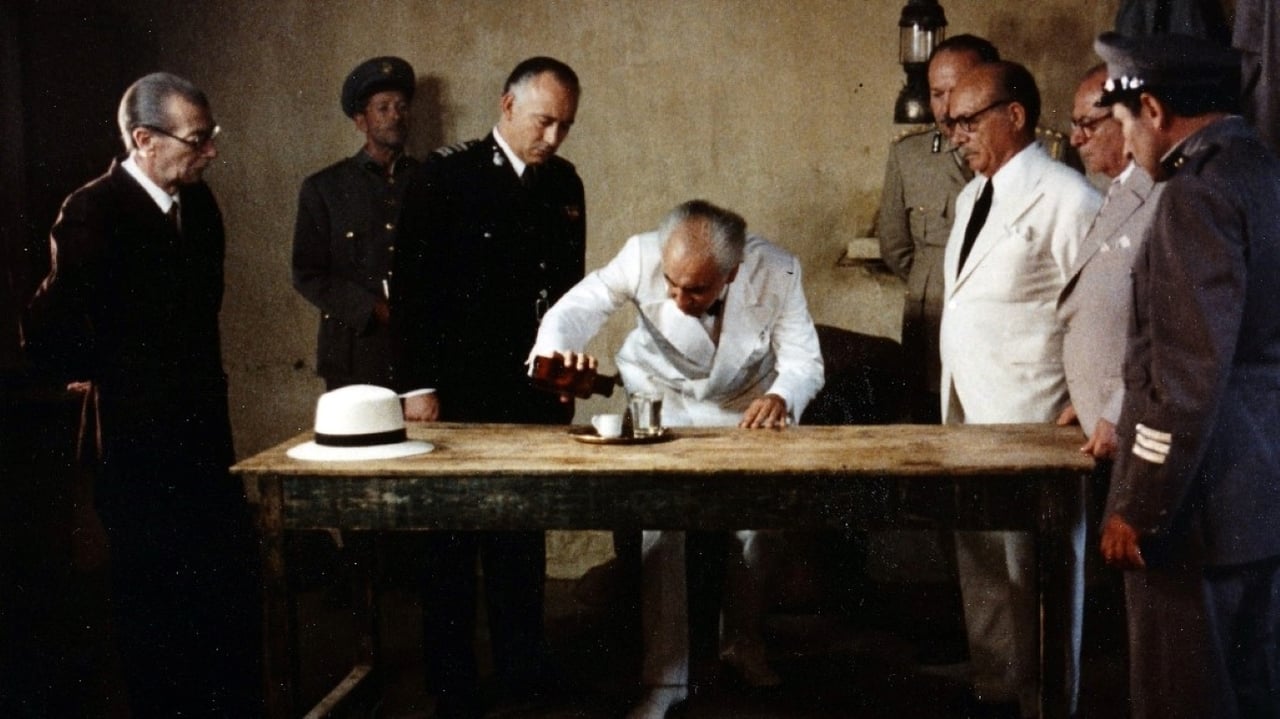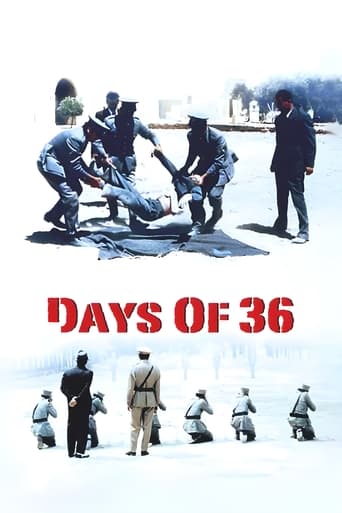



This movie is the proof that the world is becoming a sick and dumb place
View MoreLet's be realistic.
Did you people see the same film I saw?
One of the film's great tricks is that, for a time, you think it will go down a rabbit hole of unrealistic glorification.
View MoreTheodoros Angelopoulos was probably Greece's finest film maker. He had an eye for the artistic and went on to develop a style that others could never even hope to emulate, with long shots, clever and alluring angles and a kind of cinematic poetry. This is his second full length film being made in 1972. It tells the story of Sofianos who is a former drug trafficker and police informant who is arrested for the assassination of a Trade Union leader.Once in prison the local MP comes to his aid only to be taken hostage. What follows is how the authorities deal with the crisis - badly. Now this is set just prior to the Metaxas dictatorship but was made during the rule of the so called generals and as such there was censorship. So this is allegorical in terms of how it is taking a swipe at the incompetence of the authorities and the parlous state of liberty in Greece at that time.The downside is that this is very slow and more is left unanswered than is ever even asked – if that indeed makes sense. There are the long shots the great camera angles and a cast of non actors. Some of the acting is wooden and some of the scenes are painfully staged. I like to think that this is deliberate to show the unreality, mundanity or even futility of how life then was. For a modern audience though this will be a hard watch. The print is excellent and looks like it was made only last year not in 1972. If you are an aficionado of cinema then you will want to see this, I appreciated it for its vision and other aspects as described above but at times I struggled with the pace; that having been said it has stayed with me, hence my rating.
View MoreAn even more difficult and abstract film than Angelopoulos' debut "Reconstruction", his 2nd feature deals with a man arrested after a political leader is assassinated. The man seems to have been part of the assassination plot, but it is left somewhat ambiguous what his role was, if any. In jail he takes prisoner of an official who may or may not also be his cohort. While the hostage situation is at the very center of the plot, we are never in the room with the two men, and never know quite what is or isn't going on between them.Tied directly to specific events in Greek history of 1936, when Greece fell into dictatorship (I suspect only a deeper knowledge of that history would have let me experience all the film's many levels),and made during the second period of dictatorship 30+ years later (and so had to be ginger in how blatant it's anti-government stance was) on the broader scope the film is about the desperate stupidity of power, seen here via the various odd ways in which those in power try to deal with the hostage crises; rendering them at first impotent, and then violent. The pace is very slow. This is a comparatively short film by the director's standards, but actually felt longer than some of his epics. Without an emotional center or any character(s) we can identify with, using all non-actors, many of whom give fairly stiff performances, the film teeters on the edge between fascinatingly enigmatic and simply frustrating and confusing. It's all a metaphor for a society going wrong, for the rise of fascism, but it's convolutions, distant performances, and (for Angelopoulos) naturalistic visual style never really allows us inside as his later, greater, more poetic, theatrical and emotional works do. But it is beautifully made, shot from always interesting angles. Angelopoulos had yet to fully embrace his trademark super-long, flowing elaborate takes, (often multi-minute mini-films within a film) but there is a step in that direction from "Reconstruction". "Days of 36" is a transitional film, as Angelopoloulos starts to find the voice that would lead to his masterpieces, starting with his next film, "The Travelling Players", where his intellectual rigor would be balanced by an incredibly cinematic vision, and a sense of loss and pain, so one is drawn deeply in, even as you occasionally get lost on a literal level. Not a great film, but an intellectually interesting one, and required viewing for anyone interested in the arc of the work of this great master of images. And I suspect, as with all this film-makers' dense films, I will only get more from it on repeated viewings.
View MoreGreek film director Theo Angelopoulos's 1972 film, Days Of '36 (Μερες του '36, or Meres Tou '36), is the least of the several films of his that I've seen. It is also, by over a decade and a half, the earliest of the films of his I've so far seen, and, at an hour and 45 minutes, by a good margin, the shortest as well. It clearly comes across as an 'early' work in the artists' canon, because, especially when comparing it to later works, one can clearly see the artist making decisions here and being unsure of their potential success. In many ways, the film most reminds me of the first film of Werner Herzog, Signs Of Life (save the Angelopoulos film is in color, not black and white). That film was set in the Greek Islands, and was also not dependent upon a talky screenplay. There are large portions of this often wordless film that could have worked quite well in the silent era. And when the mostly anonymous characters do speak, they speak in the way that the satiric characters from the best plays of Samuel Beckett do- in riddles and whispered asides that mean little at the moment of their utterance, but which may have great meaning in retrospect.What propels the film to its success (limited as it is) are the aforementioned technical aspects of it, which differ substantially from the later films of Angelopoulos to which I am used to. There are not as many long takes that follow characters in and out of chronology, and the unobtrusive music, as mentioned, is quite a change from the electric, vivacious, and enriching scores Angelopoulos would later deploy in concert with Eleni Karaindrou. This film is considered part of a historical trilogy of films that Angelopoulos made early in his career. The other two installments are The Travelling Players and The Hunters, and only the former film is available on DVD at the moment, so I will watch it to see if it is a continuation of the themes and techniques this film brings, or if it was the beginning of a bridge to the later masterpieces that Angelopoulos would make. Yet, on its own merits, Days Of '36 deserves an audience, if not for the story it tells, nor how it is told, then for its wide variety of technical virtues that amply display the skills of a master of an art form, even very early on in his career. That even a 'failure' as this film is, on some levels, can boast such virtues, says much about how the difference between great artists and their great works of art vs. those of lesser artists is not really a difference of degree, but of kind, itself. That fact has rarely been better illustrated for the human eye. Thanks, Theo.
View MoreA deeply political film, the first of Theo's highly acclaimed trilogy (the other films being "O Thiasos" and "Oi Kynigoi"). It was filmed during the second dictatorship Greece suffered during the 20th century (1967-1974), the scenery of the film being the first dictatorship, 1936-1941. The main element is that of cleistophobia, a cleistophobia directly associated with constant and poignant political instability that leads society to an existential crisis. An important point is that, although we can roughly infer the time of the narration, no temporal indication is discernible in the film. The film swings between the historical and a- or super-historical, giving an essence of universality, while making a direct and compelling political comment.The scenery shown is limited.The place where the unionist was assassinated (by Sofianos ??), the landscape where the prison stands, a marina, a seaside resort, another open landscape, where an inauguration takes place, and the prison. The prison is the central place of the narration, carries and conveys a loaded symbolic. I would classify the scenery by the words intramural and extramural, the intramural being the scenery of the prison and the extramural that of the other places. All have a political function. The intramural being the place where the crisis of the plot evolves, the extramural being a complement to the dismemberment taking place in the intramural. The long shots give a theatrical effect and a documentary style at times. The film has a number of powerful scenes, of which i pick two out. The first is that of the music being played in the yard of the prison by request of Sofianos, giving rise to the second (less violent) prison riot. The second is the closing scene of the multiple execution, which completes a ring composition of assassinations at the beginning and at the end of the film, with death in a literal and in an abstract level being one of the main leitmotifs of the film.Interestingly, the film was awarded the first national prize in the Thessaloniki festival in 1972. No comment.
View More